Abstract
The interest in Augmented Reality (AR) in the construction industry has increased in the last decade as a means to solve “the disconnection between the physical environment and virtual information”(Chen, K., & Xue, F., 2021). As new capabilities and ways and means of production emerge involving AR, safety, as it pertains to daily use in construction, needs to be considered.
A significant amount of injuries and even death occurs on construction sites each year (OSHA), and with the advent of AR arise new challenges and opportunities with regards to health and safety within this sector.
This paper aims to address the implications AR has and will have on health and safety in construction. Through a series of empirical experiments and questionnaires, this study evaluates distractibility caused by AR. The paper concludes with evaluating AR in contrast with traditional tools, with potential to increase worksite productivity, whilst suggesting that AR may not be more distracting than traditional means and methods.
Health & Safety of emerging technologies
This paper explores the use of Augmented Reality (AR), whereby “3D virtual objects are integrated into a 3D real environment in real-time”(Azuma R., 1997), the role it currently assumes in construction environments, and, most crucially, the health and safety hazards this technology poses. Of the topics explored, emphasis was placed on distraction and environmental awareness.
The construction industry’s performance has shown a steady long-term improvement. However, there is no room for complacency. These improvements have to be in line with the constructivism of human health before, during ,and after construction is done. The current phase in the construction industry takes us to have a critical look at the new emergent technologies being introduced in the current state of construction, i.e. Digital Realities.
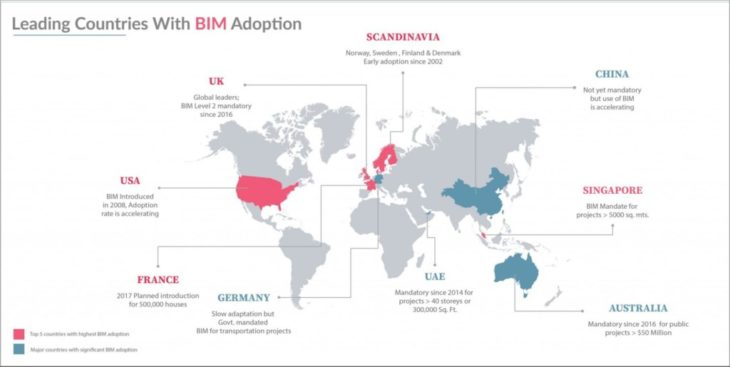
Source: united-bim.com/leading-countries-with-bim-adoption/
Digital reality refers to the wide spectrum of technologies and affordances that include Augmented Reality, Virtual Reality and Mixed Reality that simulate reality in various ways. Lately, this technology has been tried to adapt for the new construction site where the unique selling point is to go from digital to built form quicker and with less effort in terms of drawings etc. The BIM model has been adopted at various levels throughout the world and shows an actual increase in profits. (Doshi, n.d.)
Objectives
The objectives of the research explorations are to help develop an understanding into the technology in terms of safety on a construction job-site and how it relates to AR.
- To determine the causes of accidents on a construction job-site
- Understand the idea of distraction theory and how it applies to the job site
- Formulate experiments to explore the relationship between Augmented Reality and distraction and how it can implicate health and safety on a job-site
- Analyze data from the experiments to draw conclusions and probable further questions to help create a framework for these technologies when it comes to adaptability of AR technology for the job-site
Methodology
The proposed research method involved theoretical reasoning and a thorough literature review of “AR in the Construction Industry for safety applications”, where the following were studied:
- Accidents on Construction sites, (Eze et al., 2020)
- Virtual reality, and equivalent technologies for mitigation of accidents on site, (Nichols & Patel, 2002; Sacks et al., 2013)
- Distraction in technology with immersive environments, (Chen & Donmez, 2016)
- Cell Phones, and distractions within using the technology for and while performing other tasks, (Bianchi & Phillips, 2005)
- A Framework for Evaluating Augmented reality interfaces.(Chertoff et al., 2010)
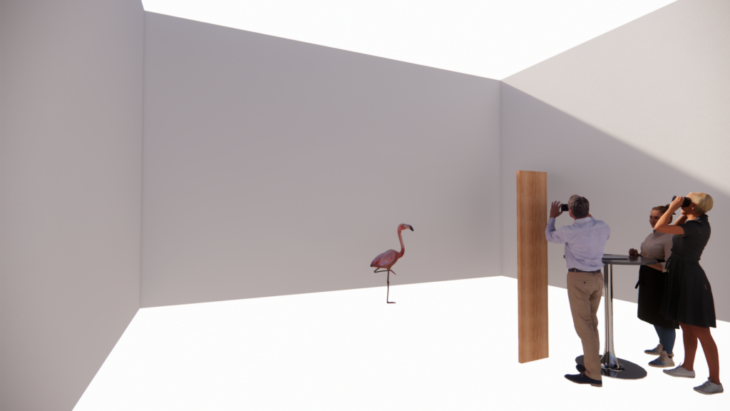
Interviews were conducted with a panel of experts from universities and construction-job sites around the world, to gauge the acceptance of the AR technology on-site and the possible opportunities and challenges we might face. Among varied opinions, it was found that mobile devices are accessible and repurposable for construction activities compared to wearable technology, as the cost of development and the discomfort while using them severely limits their usage onsite.
Following these interviews, a series of experiments were devised to obtain empirical data, to understand distractibility and performance in simple construction tasks using the AR mobile application Fologram. The experiments focused on generating primary research data by responses to questionnaires from the participants in specific experiment scenarios.
State of the Art
In research conducted previously, users of AR in various pick and place tasks in industrial applications, when asked about their experience subsequently, a survey found that of the 20 participants interviewed “all but one interviewee believed that wearing AR [head-worn displays] may increase distraction and reduce situational awareness, likely more so than using a smartphone”.
In interviews with construction professionals, the feeling was relayed that distraction was not relegated to just the use of AR, but mobile devices in general. One construction manager that was interviewed admitted that, although he personally did not yet have any experience with AR on the construction site, he was able to relate to the notion of distraction when using smart devices, stating, “when you’re on site and you’re on the phone, walking around, you’re not so focused on the site and it’s sometimes very dangerous – falling down or running into things, etc…I think it’s a risk, just like on the streets, in traffic, it’s the same danger.”
Research conducted on the use of mobile devices in other scenarios provides overwhelming evidence to support this notion. One obvious situation where this plays out is in the use of mobile devices while operating vehicles (Bianchi & Phillips, 2005).
This raises the question of whether AR alone is the culprit of such distraction, or whether the focus on the tasks or tools, digital or otherwise, have a similar impact on environmental awareness and distraction. This idea is explored further below.
Experiments
Framework
For this paper, an experiment was carried out which was inspired by the Selective Attention Test from Daniel Simons and Christopher Chabris. In this experiment, a video is shown where players in white and black shirts pass basketballs to each other and the viewer is asked to count the passes between white-shirted players. In the middle of these players, a gorilla shows up and dances through the group passing the balls between them. Because people are so focused on the passing of the ball and the players in white shirts, the darker costumed gorilla often goes unnoticed. (Simons & Chabris, 1999)
The test in this paper is to see how the focus of a participant is affected, especially with regard to their surroundings during a physical task. These tasks were done with the use of a drawing with measurements and manual implements, with the use of Augmented Reality, or both. During the experiment, different distractions were put in place. After the experiment, the participants were asked to fill in a form about their experience and see what distractions they have seen or missed.

Experiment 1:
In the first experiment, the participants’ focus is tested through a task of putting magnets on a white board. A whiteboard is placed in a workshop environment, where random faculty and students were asked one by one to participate. In the test, the participant needs to place 4 different sizes of magnets in 4 different locations on the white board.
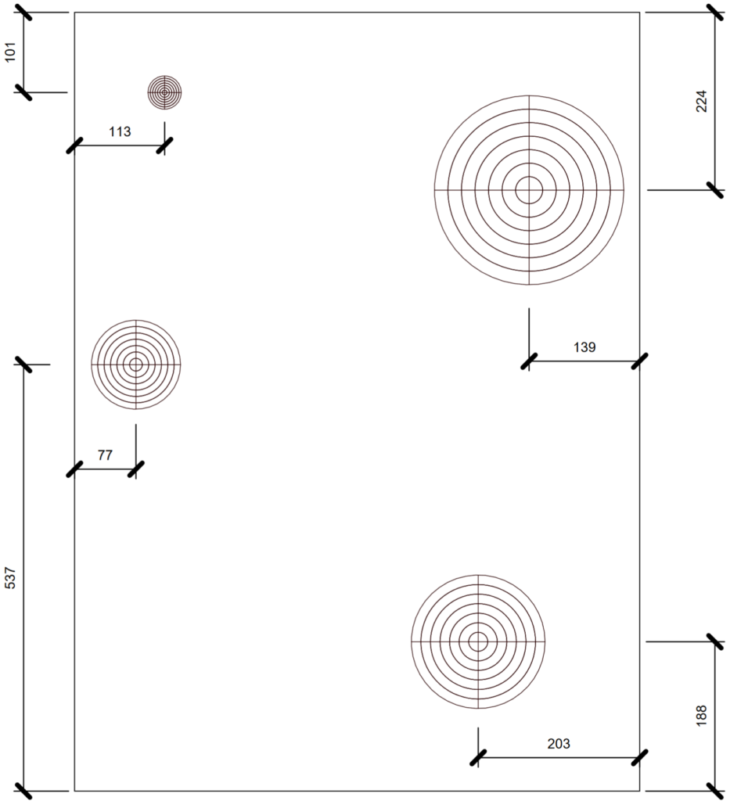
Drawing used by the participants using manual tools
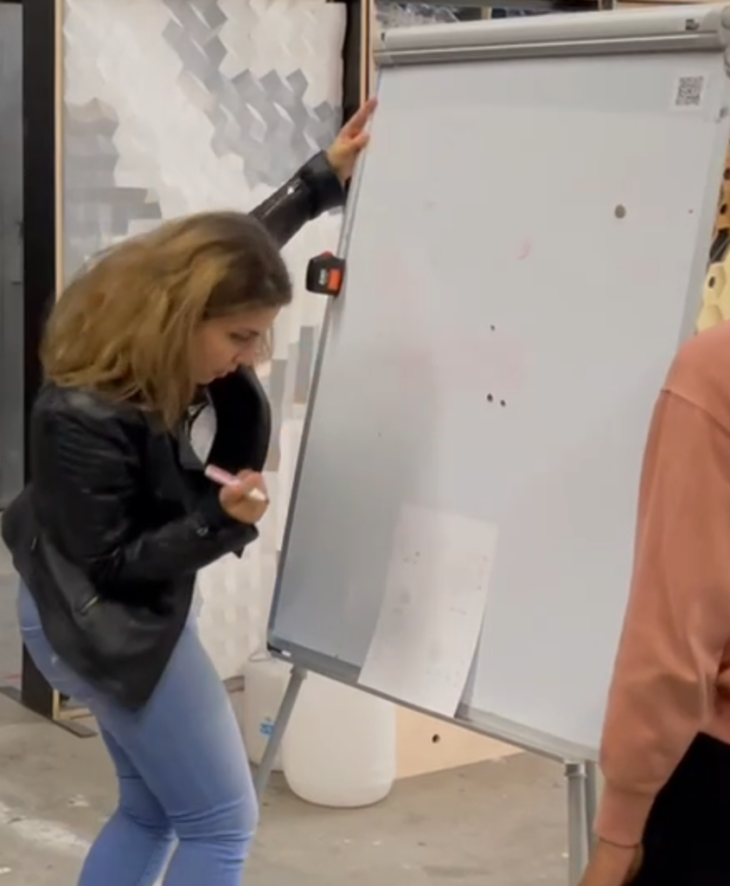
Participant in manual experiment marking positions to place the magnets
The first test was done manually with a dimensioned drawing depicting the exact locations of where the magnets should be placed, measured from the edges. The user was given a tape measure and a pen to find and mark the location on the board and place the magnet in the correct position.
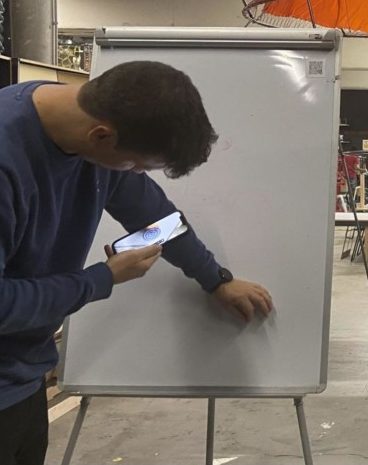
The AR overlay is being set up on the physical whiteboard

Screenshot of overlay in the AR experiment
The second method, which used the AR application Fologram on a smartphone, layered an Augmented Reality environment onto the whiteboard. After the app scans a QR code placed on the whiteboard, a collection of targets varying in size appear on the board. The user holds the phone in one hand to see these markings while they use the other hand to place the magnets – also varying in size – on the corresponding target.
Experiment 2:
In order to collect more data from multiple different tasks, a second experiment was also conducted. It was surmised from the first experiment that the whiteboard blocked too much of the participants’ vision. For this reason, the second task was done on a large, open table where the participants were asked to place 6 wooden blocks with unique color markings, which each needed to be placed and stacked at specified locations.
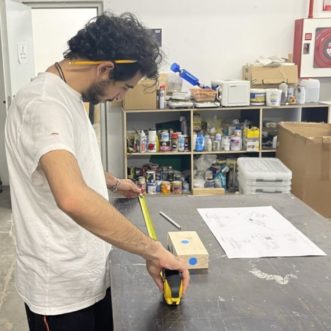
Participant using tape measure to layout blocks in manual experiment
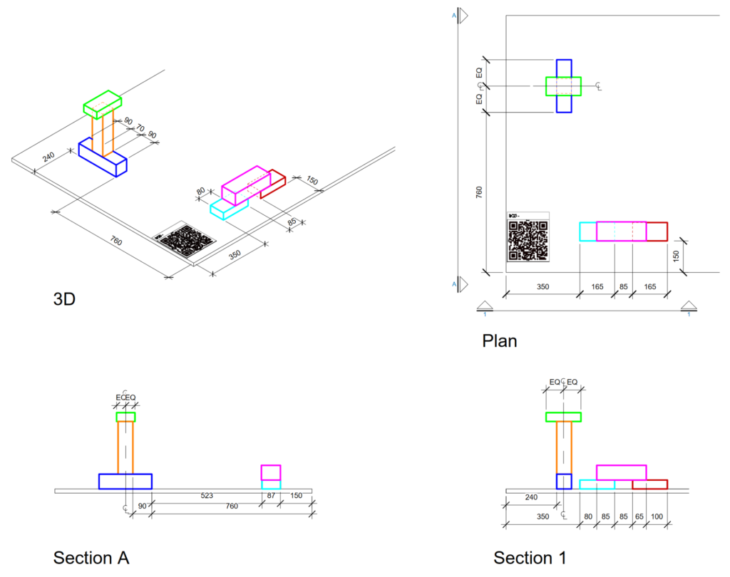
Drawing given to participants to be used in manual experiment
With the manual test, again a dimensioned drawing was given with the exact locations of the blocks. On the drawing, the blocks have the same colors as the blocks which are given to the place. A tape measure and pencil could be used to mark the distances from the edges of the table to the location of the blocks.
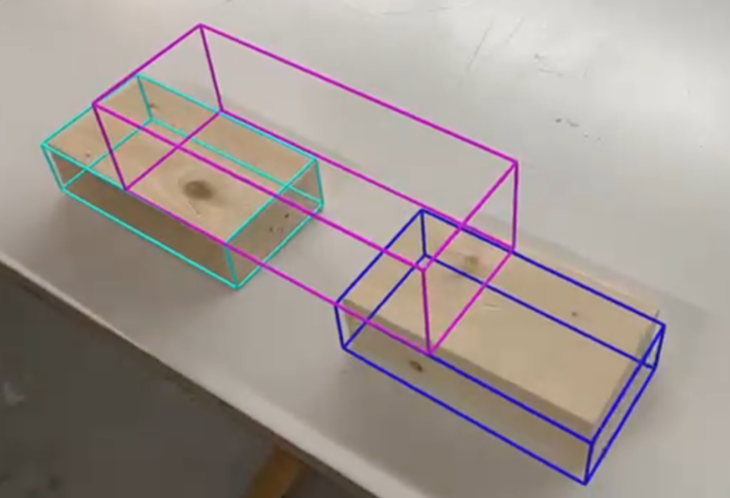
Screenshot of the AR overlay in the second experiment in progress
In the AR test, the outline of the blocks is seen through the lens of the smartphone camera. The six blocks appear in the right place on the table with the help of the QR code.
Testing for Awareness:
During the two different tests, the user is subjected to a series of different events, which were carried out during various parts of the participants’ task.

The first event, a visual test, involved a person in a horse mask, comparable to the gorilla of Daniel Simmons’ test, who walked through the background behind the experiment, but in the participants’ field of view, at various points throughout the task. Concurrently, an auditory test was conducted, whereby the phrase “Yeehaw” was shouted in close proximity to the participant. The physical sensation was tested by touching the shoulder of the participant. These events focused on testing the participants’ ability to recognize visual, auditory, and physical abnormalities in their surroundings, and how these anomalies compete with the sensory foci allotted to the tools and task at hand.
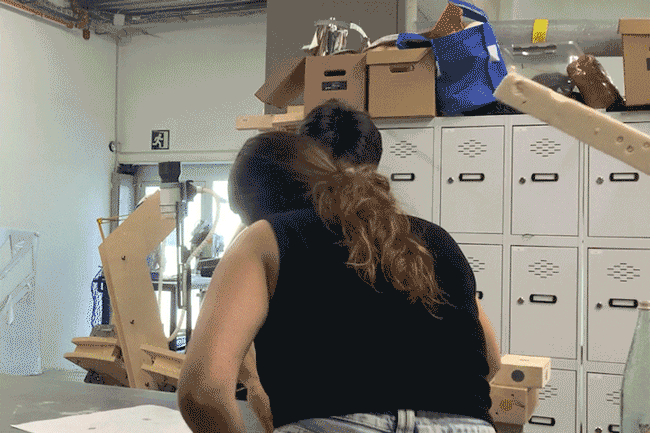
Results
The participants of the experiment were later asked to fill in a questionnaire containing questions that were trying to understand the effects of the distractions presented to them and if they were able to perceive these distractions while trying to achieve the task at hand.
Did you see the man in the horse mask? // Vision
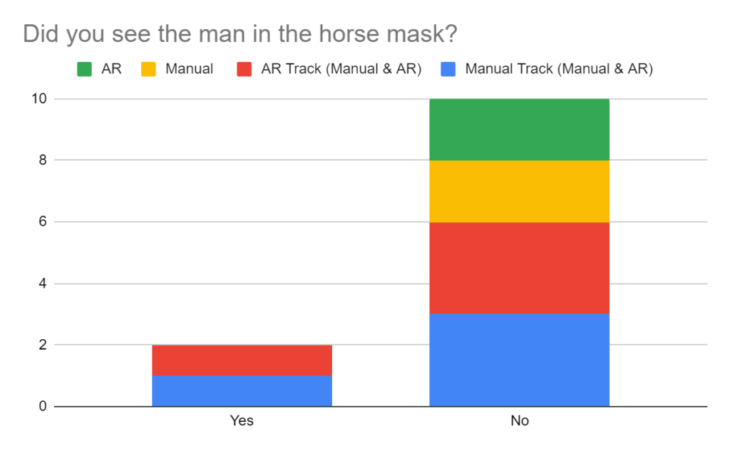 The question helped to understand how many people were actually able to perceive the man in the horse mask. The data here is divided into 4 subgroups, namely: AR only, Manual only, AR and Manual, Manual and AR. The groups were made in such a way to be able to keep the data set vivid and unbiased.
The question helped to understand how many people were actually able to perceive the man in the horse mask. The data here is divided into 4 subgroups, namely: AR only, Manual only, AR and Manual, Manual and AR. The groups were made in such a way to be able to keep the data set vivid and unbiased.
As noticeable from the above graph a majority of the participants were oblivious to the fact that there was a man in a horse mask moving around trying to distract them.
Did you notice someone tapping your shoulder? // Haptic
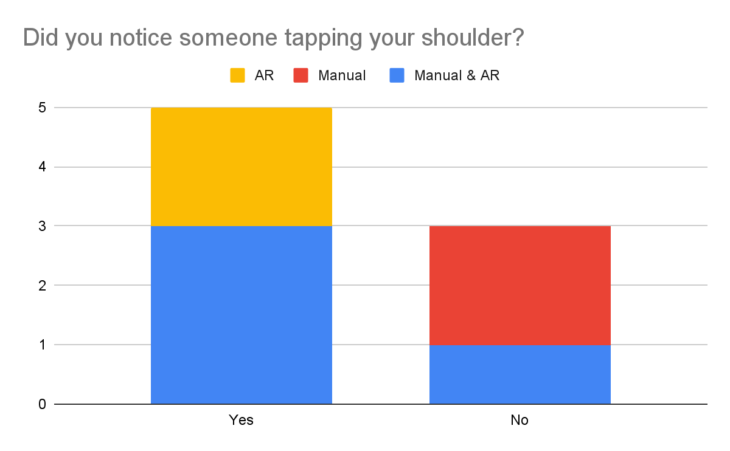
This question was meant to shed light on how much perception a participant has of their surroundings in terms of haptics. As evident from the data, almost everyone in the AR-only track were able to understand and perceive a tap on their shoulder, while all of the people from the Manual track weren’t able to perceive it.
Did you notice someone yelling “yeehaw”? // Auditory
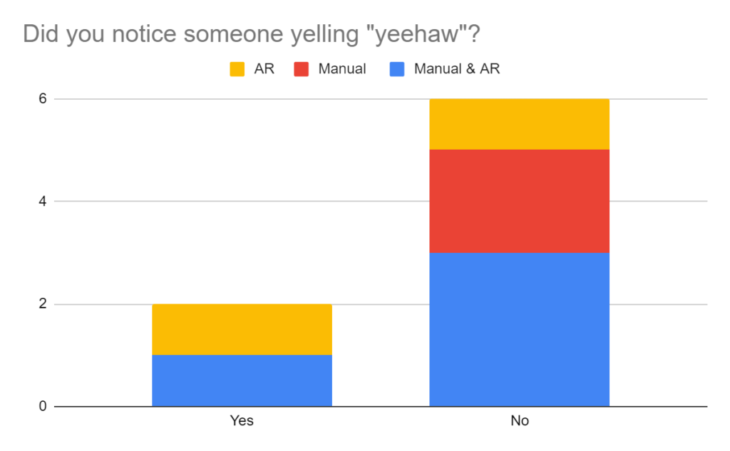 This question was meant to study how much perception a participant has of their surroundings in terms of sound. The idea was to co-relate the perception of sound to be able to help if someone calls out for a person in a busy site environment. As evident from the data, the majority of the participants did not hear the sound.
This question was meant to study how much perception a participant has of their surroundings in terms of sound. The idea was to co-relate the perception of sound to be able to help if someone calls out for a person in a busy site environment. As evident from the data, the majority of the participants did not hear the sound.
Conclusions
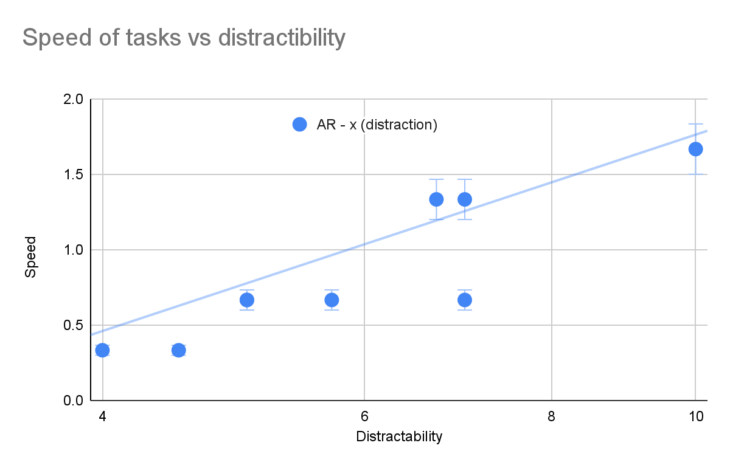
Correlation between Speed and Distractibility in AR interfaces
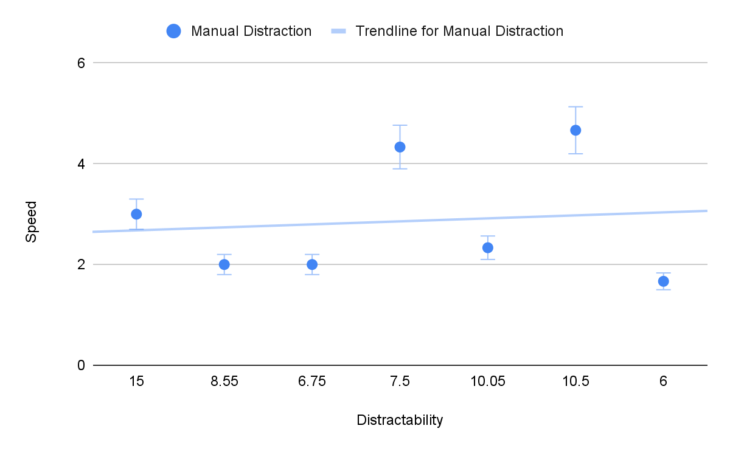
Correlation between Speed and Distractibility in Traditional interfaces
- AR as a tool is perhaps not significantly more distracting than traditional tools
- AR significantly improved the time taken to finish the specified task, but there may be potential for improvement with the incorporation of sensory feedback.
- There are considerable learning curves to use AR-assisted technology especially for the digitally illiterate.
Note:
All participants in the survey gave consent to use the interview data.
The people interviewed were engineers/architects/designers already using some form of AR-assisted technology and well versed in Computer interfaces, lack of construction workers In the sample set.
AUGMENTED REALITY AND CONSTRUCTION SAFETY is a project by MRAC 01 students Mit Patel, Vincent Verster, Libish Murugesan, and Robert Michael Blackburn, during the Theory II & III seminars of the second and third terms. Studio was taught by IAAC faculty Mathilde Marengo.
Sources
- Chertoff, D., Goldiez, B. F., & Jr, J. (2010). Virtual Experience Test: A virtual environment evaluation questionnaire. 103–110.
https://doi.org/10.1109/VR.2010.5444804
- Bianchi, A., & Phillips, J. G. (2005). Psychological Predictors of Problem Mobile Phone Use. CyberPsychology & Behavior, 8(1), 39–51.
https://doi.org/10.1089/cpb.2005.8.39
- Chen, H.-Y. W., & Donmez, B. (2016). What drives technology-based distractions? A structural equation model on social-psychological factors of technology-based driver distraction engagement. Accident Analysis & Prevention, 91, 166–174.
https://doi.org/10.1016/j.aap.2015.08.015
- Doshi, P. (n.d.). Leading Countries With BIM Adoption—United-BIM. Retrieved May 11, 2022, from united-bim.com/leading-countries-with-bim-adoption/
- Eze, E., Sofolahan, O., & Siunoje, L. (2020). Health and Safety Management on Construction Projects: The View of Construction Tradespeople. CSID Journal of Infrastructure Development, 3, 152.
https://doi.org/10.32783/csid-jid.v3i2.165
- From VR To ER: Virtual Reality Is Injuring Users, Landing Them In Hospitals. (2022, February 2). IndiaTimes.
https://www.indiatimes.com/technology/news/virtual-reality-injuries-rising-in-hospitals-561025.html
- Getuli, V., Giusti, T., Capone, P., Sorbi, T., & Bruttini, A. (2018). A Project Framework to Introduce Virtual Reality in Construction Health and Safety. IN_BO. Ricerche e Progetti per Il Territorio, La Città e l’architettura, 9(13), 166–175.
https://doi.org/10.6092/issn.2036-1602/8830
- Kim, S., Nussbaum, M., & Gabbard, J. (2016). Augmented Reality “Smart Glasses” in the Workplace: Industry Perspectives and Challenges for Worker Safety and Health. IIE Transactions on Occupational Ergonomics and Human Factors, 4, 00–00.
https://doi.org/10.1080/21577323.2016.1214635
- Liang, Y., Reyes, M. L., & Lee, J. D. (2007). Real-Time Detection of Driver Cognitive Distraction Using Support Vector Machines. IEEE Transactions on Intelligent Transportation Systems, 8(2), 340–350.
https://doi.org/10.1109/TITS.2007.895298
- Nedel, L., de Souza, V. C., Menin, A., Sebben, L., Oliveira, J., Faria, F., & Maciel, A. (2016). Using Immersive Virtual Reality to Reduce Work Accidents in Developing Countries. IEEE Computer Graphics and Applications, 36(2), 36–46.
https://doi.org/10.1109/MCG.2016.19
- Nichols, S., & Patel, H. (2002). Health and safety implications of virtual reality: A review of empirical evidence. Applied Ergonomics, 33(3), 251–271.
https://doi.org/10.1016/S0003-6870(02)00020-0
- Sacks, R., Perlman, A., & Barak, R. (2013). Construction safety training using immersive virtual reality. Construction Management and Economics, 31(9), 1005–1017.
https://doi.org/10.1080/01446193.2013.828844
- Schneider, R. (2018, September 22). DESIGN FOR MIXED REALITY EXPERIENCES.
- Simons, D. J., & Chabris, C. F. (1999). Gorillas in Our Midst: Sustained Inattentional Blindness for Dynamic Events. Perception, 28(9), 1059–1074.
https://doi.org/10.1068/p281059
- VR, Metaverse Insurance Claims Jump 31 Percent. (2022, February 14). XR Today.
- Ahmed, S. (2019). A Review on Using Opportunities of Augmented Reality and Virtual Reality in Construction Project Management. 11, 1839–1852.
https://doi.org/10.2478/otmcj-2018-0012
- Bett, M. (2011). Can voice interaction help reducing the level of distraction and prevent accidents?
https://www.academia.edu/2665460/Can_voice_interaction_help_reducing_the_level_of_distraction_and_prevent_accidents
- Chang, E., Kim, H.-T., & Yoo, B. (2020). Virtual Reality Sickness: A Review of Causes and Measurements. International Journal of Human-Computer Interaction, 36, 1–25.
https://doi.org/10.1080/10447318.2020.1778351
- Chen, H.-Y. W., & Donmez, B. (2016). What drives technology-based distractions? A structural equation model on social-psychological factors of technology-based driver distraction engagement. Accident Analysis & Prevention, 91, 166–174.
https://doi.org/10.1016/j.aap.2015.08.015
- Cho, C., & Park, J. (2018). An Embedded Sensory System for Worker Safety: Prototype Development and Evaluation. Sensors, 18(4), 1200.
https://doi.org/10.3390/s18041200
- Construction safety training using immersive virtual reality: Construction Management and Economics: Vol 31, No 9. (n.d.). Retrieved June 13, 2022, from
https://www.tandfonline.com/doi/abs/10.1080/01446193.2013.828844
- Dai, F., Olorunfemi, A., Peng, W., Cao, D., & Luo, X. (2021). Can mixed reality enhance safety communication on construction sites? An industry perspective. Safety Science, 133, 105009.
https://doi.org/10.1016/j.ssci.2020.105009
- Dealing with digital distraction. (n.d.). Retrieved June 13, 2022, from
https://www.apa.org/news/press/releases/2018/08/digital-distraction
- Development of a Haptic Interface for Safe Human Roobt Collaboration: (2014). Proceedings of the 4th International Conference on Pervasive and Embedded Computing and Communication Systems, 61–66.
https://doi.org/10.5220/0004803400610066
- Distracted driving: Prevalence, problems, and prevention: International Journal of Injury Control and Safety Promotion: Vol 22, No 3. (n.d.). Retrieved June 13, 2022, from
https://www.tandfonline.com/doi/full/10.1080/17457300.2013.879482
- Hasanzadeh, S., Polys, N. F., & de la Garza, J. M. (2020). Presence, Mixed Reality, and Risk-Taking Behavior: A Study in Safety Interventions. IEEE Transactions on Visualization and Computer Graphics, 26(5), 2115–2125.
https://doi.org/10.1109/TVCG.2020.2973055
- Kim, S., Nussbaum, M. A., & Gabbard, J. L. (2016). Augmented Reality “Smart Glasses” in the Workplace: Industry Perspectives and Challenges for Worker Safety and Health. IIE Transactions on Occupational Ergonomics and Human Factors, 4(4), 253–258.
https://doi.org/10.1080/21577323.2016.1214635
- Mazloumi Gavgani, A., Walker, F. R., Hodgson, D. M., & Nalivaiko, E. (2018). A comparative study of cybersickness during exposure to virtual reality and “classic” motion sickness: Are they different? Journal of Applied Physiology (Bethesda, Md.: 1985).
https://doi.org/10.1152/japplphysiol.00338.2018
- Mikusova, M., Wachnicka, J., & Zukowska, J. (2021). Research on the Use of Mobile Devices and Headphones on Pedestrian Crossings—Pilot Case Study from Slovakia. Safety, 7(1), 17.
https://doi.org/10.3390/safety7010017
- Mitterberger, D. (2021). CHRONOTOPE – digital craft and embodiment in architecture.
- Mitterberger, D., & Derme, T. (2020). Digital soil: Robotically 3D-printed granular bio-composites. International Journal of Architectural Computing, 18(2), 194–211.
https://doi.org/10.1177/1478077120924996
- Mitterberger, D., Dörfler, K., Sandy, T., Salveridou, F., Hutter, M., Gramazio, F., & Kohler, M. (2020). Augmented bricklaying. Construction Robotics, 4(3), 151–161.
https://doi.org/10.1007/s41693-020-00035-8
- Ros, M., Neuwirth, L. S., Ng, S., Debien, B., Molinari, N., Gatto, F., & Lonjon, N. (2021). The Effects of an Immersive Virtual Reality Application in First Person Point-of-View (IVRA-FPV) on The Learning and Generalized Performance of a Lumbar Puncture Medical Procedure. Educational Technology Research and Development, 69(3), 1529–1556.
https://doi.org/10.1007/s11423-021-10003-w
- Safety | Free Full-Text | A Review of Virtual and Mixed Reality Applications in Construction Safety Literature. (n.d.). Retrieved June 13, 2022, from
https://www.mdpi.com/2313-576X/5/3/51?type=check_update&version=2
- Summerskill, S., Porter, J., & Burnett, G. (2003). Feeling your way home: The use of haptic interfaces within cars to make safety pleasurable.
https://doi.org/10.1201/9780203608173-c52
- Tixier, A. J.-P., & Albert, A. (2013). Teaching construction hazard recognition through high fidelity augmented reality. 23.1139.1-23.1139.15.
https://peer.asee.org/teaching-construction-hazard-recognition-through-high-fidelity-augmented-reality
- Using Immersive Augmented Reality to Assess the Effectiveness of Construction Safety Training -Journal of Construction Engineering and Project Management | Korea Science. (n.d.). Retrieved June 13, 2022, from
http://koreascience.or.kr/article/JAKO201905662892590.page
